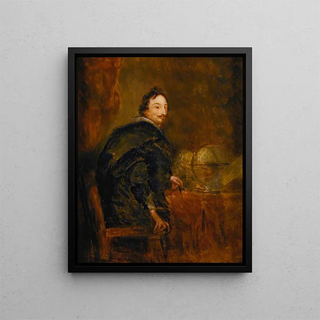Art print | Lucas van Uffele - Antoine van Dyck


View from behind

Frame (optional)
In the fascinating world of baroque art, the art print of "Lucas van Uffele" by Antoine van Dyck stands as a vibrant testament to the virtuosity of two masters. Antoine van Dyck, a prodigious student of Rubens, skillfully fused rich colors with psychological depth to create a work that transcends a simple portrait. This art print, faithful to the original, immerses us in a world where each brushstroke tells a story, where light and shadow dance across the canvas, revealing the complexity of human emotions. Contemplating this piece, the viewer is invited to explore not only the face of Lucas van Uffele but also the soul of the era, marked by an unceasing quest for beauty and truth.
Style and uniqueness of the work
Van Dyck's work is distinguished by its flamboyant style and its ability to capture the personality of its subjects. In "Lucas van Uffele," the painter manages to combine the grandeur of the portrait with palpable intimacy. The gaze of the model, both penetrating and serene, seems to defy time, while the drapery of his clothing, skillfully rendered, reveals impressive technical mastery. The delicate nuances of the flesh contrast with the deep colors of the background, creating an atmosphere that is both solemn and lively. The composition, balanced and harmonious, reflects careful thought on how each element interacts to enhance the visual impact of the work. Van Dyck does not merely depict Lucas van Uffele; he endows him with an almost divine aura, transforming the portrait into a celebration of human dignity.
The artist and his influence
Antoine van Dyck, born in Antwerp in 1599, is undoubtedly one of the greatest portraitists of his time. His artistic journey, marked by training under Rubens, allowed him to incorporate techniques of Flemish painting while developing a personal style unique to him. Van Dyck succeeded in establishing himself at the court of England, where he painted numerous portraits of royalty and aristocracy, contributing to the re-

Matte finish

View from behind

Frame (optional)
In the fascinating world of baroque art, the art print of "Lucas van Uffele" by Antoine van Dyck stands as a vibrant testament to the virtuosity of two masters. Antoine van Dyck, a prodigious student of Rubens, skillfully fused rich colors with psychological depth to create a work that transcends a simple portrait. This art print, faithful to the original, immerses us in a world where each brushstroke tells a story, where light and shadow dance across the canvas, revealing the complexity of human emotions. Contemplating this piece, the viewer is invited to explore not only the face of Lucas van Uffele but also the soul of the era, marked by an unceasing quest for beauty and truth.
Style and uniqueness of the work
Van Dyck's work is distinguished by its flamboyant style and its ability to capture the personality of its subjects. In "Lucas van Uffele," the painter manages to combine the grandeur of the portrait with palpable intimacy. The gaze of the model, both penetrating and serene, seems to defy time, while the drapery of his clothing, skillfully rendered, reveals impressive technical mastery. The delicate nuances of the flesh contrast with the deep colors of the background, creating an atmosphere that is both solemn and lively. The composition, balanced and harmonious, reflects careful thought on how each element interacts to enhance the visual impact of the work. Van Dyck does not merely depict Lucas van Uffele; he endows him with an almost divine aura, transforming the portrait into a celebration of human dignity.
The artist and his influence
Antoine van Dyck, born in Antwerp in 1599, is undoubtedly one of the greatest portraitists of his time. His artistic journey, marked by training under Rubens, allowed him to incorporate techniques of Flemish painting while developing a personal style unique to him. Van Dyck succeeded in establishing himself at the court of England, where he painted numerous portraits of royalty and aristocracy, contributing to the re-






